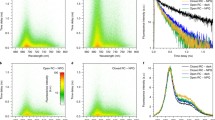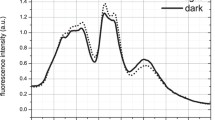Abstract
We present a unifying mechanism for photoinhibition based on current obsevations from in vivo studies rather than from in vitro studies with isolated thylakoids or PS II membranes. In vitro studies have limited relevance for in vivo photoinhibition because very high light is used with photon exposures rarely encountered in nature, and most of the multiple, interacting, protective strategies of PS II regulation in living cells are not functional. It is now established that the photoinactivation of Photosystem II in vivo is a probability and light-dosage event which depends on the photons absorbed and not the irradiance per se. As the reciprocity law is obeyed and target theory analysis strongly suggests that only one photon is required, we propose that a single dominant molecular mechanism occurs in vivo with one photon inactivating PS II under limiting, saturating or sustained high light. Two mechanisms have been proposed for photoinhibition under high light, acceptor-side and donor-side photoinhibition [see Aro et al. (1994) Biochim Biophys Acta 1143: 113–134], and another mechanism for very low light, the low-light syndrome [Keren et al. (1995) J Biol Chem 270: 806–814]. Based on the exciton-radical pair equilibrium model of exciton dynamics, we propose a unifying mechanism for the photoinactivation of PS II in vivo under steady-state photosynthesis that depends on the generation and maintenance of increased concentrations of the primary radical pair, P680+Pheo−, and the different ways charge recombination is regulated under varying environmental conditions [Anderson et al. (1997) Physiol Plant 100: 214–223]. We suggest that the primary cause of damage to D1 protein is P680+, rather than singlet O2 formed from triplet P680, or other reactive oxygen species.
Similar content being viewed by others
References
Altmann KI, Gerber GB and Okada S (1970) Radiation Biology, Vol I, Cells, pp 329–336. Academic Press, New York
Anderson JM and Aro E-M (1994) Grana stacking and protection of Photosystem II in thylakoid membranes of higher plant leaves under sustained high irradiance: An hypothesis. Photosynth Res 41: 315–326
Anderson JM, Chow WS and Park Y-I (1995) The grand design of photosynthesis: Acclimation of the photosynthetic apparatus to environmental cues. Photosynth Res 46: 129–139
Anderson JM, Park Y-I and Chow WS (1997) Photoinactivation and photoprotection of Photosystem II in nature. Physiol Plant 100: 214–223
Aro E-M, Virgin I and Andersson B (1993) Photoinhibition of Photosystem II. Inactivation, protein damage and turnover. Biochim Biophys Acta 1143: 113–134
Asada K (1994) Production and action of active oxygen species in photosynthetic tissues. In: Foyer CH (ed) Causes of Photooxidative Stress and Amelioration of Defence System in Plants, pp 77–104. CRC Press, Baton Rouge
Barber J (1995) Molecular basis of the vulnerability of Photosystem II to damage by light. Aust J Plant Physiol 22: 201–208
Baroli I and Melis A (1996) Photoinhibition and repair in Dunaliella salina acclimated to different growth irradiances. Planta 198: 640–646
Boekema EJ, Hanaker B, Bald D, Kruip J, Nield J, Boonstra AF, Barber J and Rögner M (1995) Supramolecular structure of the Photosystem II complex from green plants and cyanobacteria. Proc Natl Acad Sci USA 92: 175–179
Cleland RE, Melis A and Neale PJ (1986) Mechanism of photoinhibition: photochemical reaction center inactivation in system II of chloroplasts. Photosynth Res 9: 79–88
ChowWS (1994) Photoprotection and photoinhibitory damage. Adv Mol Cell Biol 10: 151–196
Dau H (1994) Molecular mechanisms and quantitative models of variable Photosystem II fluorescence. Photochem Photobiol 60: 1–23
Demmig-Adams B and Adams WW (1992) Photoprotection and other other responses of plants to high light stress. Annu Rev Plant Phys Plant Mol Biol 43: 599–626
Horton P, Ruban AV and Walters RG (1996) Regulation of light harvesting in green plants. Annu Rev Plant Physiol Plant Mol Biol 47: 655–684
Huner NPA, Maxwell DP, Gray GR, Savitch LV, Kroll M, Ivanov and Falk S (1996) Sensing environmental temperature change through inbalance between energy supply and energy consumption: Redox state of Photosystem II. Physiol Plant 98: 358–364
Hutchinson F and Pollard E (1961) Target theory and radiation effects on biological molecules. In: Errera M and Foressberg A (eds) Mechanisms in Radiobiology, Vol I, pp 71–92. Academic Press, New York
Johnson GN, Rutherford AW and Krieger A (1995) A change in the midpotential of the quinone QA in Photosystem II associated with photoinactivation of oxygen evolution. Biochim Biophys Acta 1229: 202–207
Jones LW and Kok B (1966) Photoinhibition of chloroplasts reactions. Kinetics and action spectra. Plant Physiol 41: 1037–1043
Keren N, Gong H and Ohad I (1995) Oscillations of reaction center-D1 protein degradation in vivo induced by repetitive flashes. Correlation between the level of RCII-QB ? and protein degradation in low light. J Biol Chem 270: 806–814
Keren N, Berg A, van Kan PJM, Levanon H and Ohad I (1997) Mechanism of Photosystem II photoinactivation and D1 protein degradation at low light: The role of back electron flow. Proc Natl Acad Sci USA 94: 1579–1584
Kettunen R, Tyystjärvi E and Aro E-M (1996) Degradation pattern of Photosystem II reaction center protein D1 in intact leaves: The major photoinhibition-induced cleavage site on A1 polypeptide is located amino terminally of the DE loop. Plant Physiol 111: 1183–1190
Klimov VV, Allakhverdiev SI, Demeter S and Krasnovskii AA (1979) Pheophytin reduction in Photosystem II of chloroplasts in relation to oxidation-reduction potential of the medium. Dokl Akad Nauk SSR 249: 227–230
Krieger A and Weis E (1993) The role of calcium in the pHdependent control of Photosystem II. Photosynth Res 37: 117–130
Melis A (1991) Dynamics of photosynthetic membrane composition and function. Biochim Biophys Acta 1058: 87–101
Nagy L, Balint E, Barber J, Ringler A, Cook KM and Maroti P (1995) Photoinhibition and law of reciprocity in photosynthetic reactions of Synechocystis sp. PCC 6803. J Plant Physiol 145: 410–415
Napiwotzki A, Bergmann A, Decker K, Legall H, Eckert H-J, Eichler H-J and Renger G (1997) Acceptor side photoinhibition in Photosystem II: On the possible effects of the functional integrity of the PS II donor side of photoinhibition of stable charge separation. Photosynth Res 52: 199–213
Ohad I, Keren N, Zer H, Gong H, Mor TS, Gal A, Tal S and Domovich Y (1994) In: Baker NR and Bowyer JR (eds) Photoinhibition of Photosynthesis: From Molecular Mechanisms to the Field, pp 161–177. Bios Scientific Publications, Oxford
Ögren E (1991) Prediction of photoinhibition of photosynthesis from measurements of fluorescence quenching components. Planta 184: 538–544
Öquist G, Chow WS and Anderson JM (1992) Photoinhibition of photosynthesis represents a mechanism for the long-term regulation of photosynthesis. Planta 186: 450–460
Park Y-I, Chow WS and Anderson JM (1995) Light inactivation of functional Photosystem II in leaves of peas grown in moderate light depends on photon exposure. Planta 196: 401–411
Park Y-I, Anderson JM and Chow WS (1996a) Photoinactivation of functional Photosystem II and D1-protein synthesis in vivo are independent of the modulation of the photosynthetic apparatus by growth irradiance. Planta 198: 300–309
Park Y-I, Chow WS, Anderson JM and Hurry VM (1996b) Differential susceptibility of Photosystem II to light stress in light-acclimated peas leaves depends on the capacity for photochemical and non-radiative dissipation of light. Plant Sci 115: 137–149
Park Y-I, Chow WS, Osmond CB and Anderson JM (1996c) Electron transport to oxygen mitigates against the photoinactivation of Photosystem II in vivo. Photosynth Res 50: 23–32
Park Y-I, Chow WS and Anderson JM (1997) Antenna size dependency of photoinactivation of Photosystem II in light-acclimated pea leaves. Plant Physiol 115: 151–157
Riistama S, Puustinen A, Garcia-Horsmann A, Itwata S, Michel H and Wikström(1996) Chanelling of dioxygen into the respiratory enzyme. Biochim Biophys Acta 1275: 1–4
Schatz GH, Brock H and Holzwarth AR (1988). Kinetic and energy model for the primary processes of Photosystem II. Biophys J 54: 397–405
Schreiber U and Krieger A (1996) Two fundamentally different types of variable fluorescence in vivo. FEBS Lett 397: 131–135
Shen Y-K, Chow WS, Park Y-I and Anderson JM (1996) Photoinactivation of Photosystem II by cumulative exposure to short light pulses during the induction period of photosynthesis. Photosynth Res 47: 51–59
Sinclair J, Park Y-I, Chow WS and Anderson JM (1996) Target theory and the photoinactivation of PS II. Photosynth Res 50: 33–40
Sisson WB and Caldwell MM (1977) Atmospheric ozone depletion: Reduction of photosynthesis and growth of a sensitive higher plant exposed to enhanced UV-B radiation. J Expt Bot 28: 691–705
Sonoike K (1996) Photoinhibition of Photosystem I: Its physiological significance in the chilling sensitivity of plants. Plant Cell Physiol 37: 239–247
Tsukihara T, Aoyama H, Yamashita E, Tomizaki T, Yamaguchi H, Shinzawa-Itoh K, Nakashima R, Yaono R and Yoshikawa S (1996) The whole structure of the 13-subunit oxidized cytochrome c oxidase at 2.8Å. Science 272: 1136–1144
Tyystjärvi E and Aro E-M (1996) The rate constant of photoinhibition, measured in lincomycin-treated leaves, is directly proportional to light intensity. Proc Natl Acad Sci USA 93: 2213–2218
Tyystjärvi E, Kettunen R and Aro E-M (1991) Small lightharvesting antenna does not protect from photoinhibition. Plant Physiol 97: 477–483
Tyystjärvi E, Koivuniemi A, Kettunen R and Aro E-M (1994) The rate constant of photoinhibition in vitro is independent of the antenna size of Photosystem II but depends on temperature. Biochim Biophs Acta 1186: 177–185
van Mieghem F, Brettel K, Hillmann B, Kamlowski A, Rutherford WA and Schlodder E (1995) Charge recombination reactions in Photosystem II. I. Yields, recombination pathways, and kinetics of the primary pair. Biochem 34: 4798–4813
Vass I, Styring S, Hundahl T, Koivuniemi A, Aro E-M and Andersson B (1992) Reversible and irreversible intermediates during photoinhibition of Photosystem II: Stable reduced QA species promote chlorophyll triplet formation. Proc Natl Acad Sci USA 89: 1408–1412
Weis A and Berry J (1987) Quantum efficiency of Photosystem II in relation to energy dependent quenching of chlorophyll fluorescence. Biochim Biophys Acta 894: 198–208
Wydrzynski T, Hillier W and Messinger J (1996) On the functional significance of substrate accessibility in the photosynthetic water oxidation mechanism. Physiol Plant 96: 342–350
Author information
Authors and Affiliations
Rights and permissions
About this article
Cite this article
Anderson, J.M., Park, YI. & Chow, W.S. Unifying model for the photoinactivation of Photosystem II in vivo under steady-state photosynthesis. Photosynthesis Research 56, 1–13 (1998). https://doi.org/10.1023/A:1005946808488
Issue Date:
DOI: https://doi.org/10.1023/A:1005946808488




